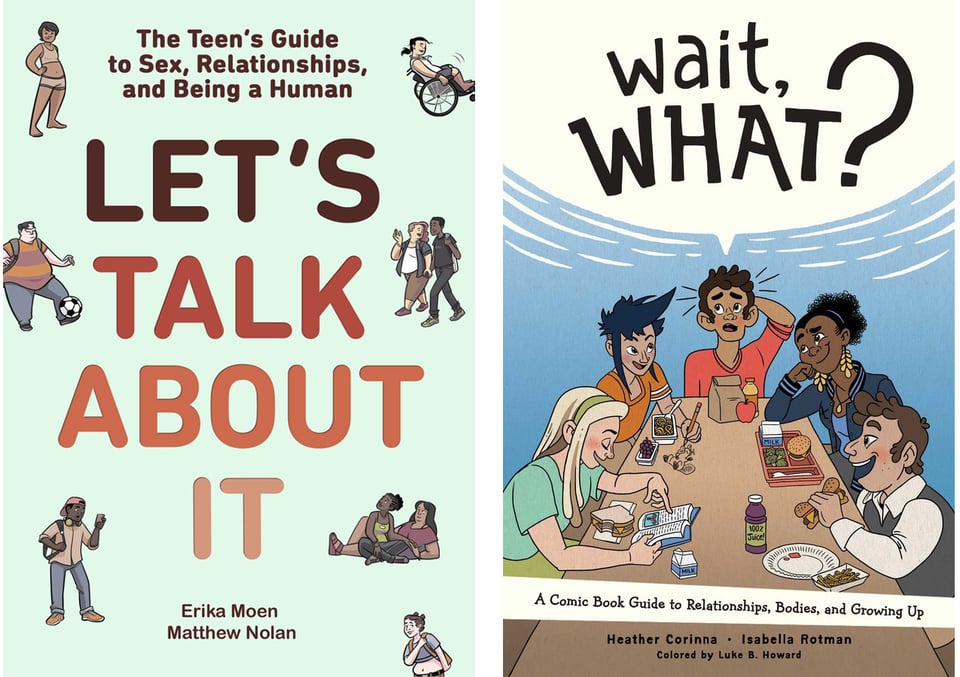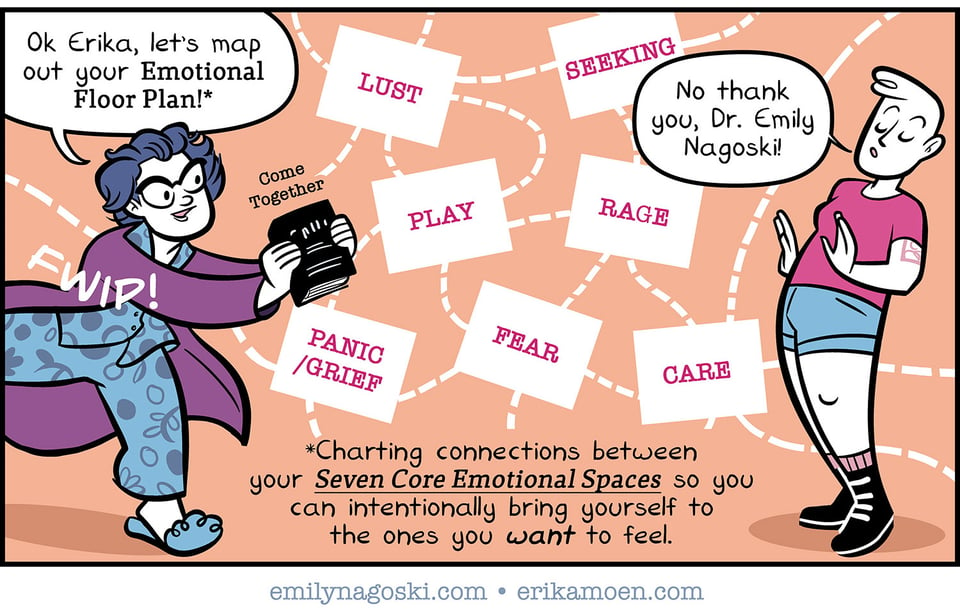Healthy sex ed resources for young men
Hi everyone-
This week is a guest post by Robyn Manning-Samuels, one of Emily’s sex educator friends and co-author on the upcoming Come Together Workbook and Emotional Floor Plan Card Decks!
Q: Hi to Emily and all who help :) I am a mom of two cis gendered boys/almost young men, of 12 and 17. I love them dearly and want to continue to support them as they grow into adults. I want them to understand their privilege, their responsibility, and the opportunity they have to be wonderful, caring people. I'm looking for healthy sex and emotional educational resources for boys and young men.
A: Hey, that's me, Robyn! I can help! Hello mom of young adults, I appreciate you reaching out looking for resources. Your kids will definitely benefit just from having a parent who is conscientious and actively thinking about how to counter traditional male socialization.
I can break these recommendations down into three categories: tween appropriate (12-15 range), teen/young adult appropriate (12-18 range), and parent resources. The reason for this semi-arbitrary breakdown has more to do with library classifications of different books and attempts at censorship related to those classifications. It also follows the recommended sex education topics for different age groups, which includes puberty and identity development in middle school and dating, consent, and safety in high school.
Let’s start with tweens first. In my opinion, one of the best age-appropriate books about sex, identity, and physical development for this age group is Heather Corinna and Isabella Rotman’s book “Wait, what?” It is inclusive, covers a wide range of topics that kids at this stage of development encounter, and is a beautiful and easy to read comic. Heather Corinna is the founder of the website Scarleteen and the author of several books about sex and culture. Their book “s.e.x: the all-you-need-to-know sexuality guide to get you through your teens and twenties” is a book I’d recommend for the teen/twenties age group.

Speaking of, for the teen/young adult group, there’s a comic similar to “Wait, What?” called “Let’s Talk About It” by dynamic duo Erika Moen and Mathew Nolan. It’s more explicit, covers a broader range of topics around sex and relationships, and is one of the most censored sex ed books for this age range! That’s how you know it’s covering important topics. Also, Last Week Tonight included it in a segment about sex education content that has been banned for no reason. Erika and Matthew publish the webcomic Oh Joy Sex Toy, which covers everything from sex toy reviews to processing gender transition in beautiful comics. They’re also friends of the Unruly Wellness team! (well, I personally haven’t met them, but everyone else has…)

For parents, I would recommend reading books like “Boys and Sex” by Peggy Orenstein or “DIY: The Wonderfully Weird History and Science of Masturbation” by Eric Sprankle. These books cover a lot of common narratives around male socialization and sex, including some common myths and toxic narratives they might come across when talking with their friends and acquaintances.
This brings me to my last resource and probably the most important one: You, the parent!
One of my main interests is mapping the development of American masculine identity, and the common thread across generations is the contradictory narrative of comparison to your opposite. In recent decades, this narrative has been challenged by feminism, queer and trans liberation movements, and racial equity activism. At the end of the day, what does it mean to be a man without a comparison to women and competition between other men?
Take that away and what’s left?
Well, what’s left is an opportunity for healthy attachment development and emotional processing! Helping young boys learn how to communicate emotionally, how to build trusting relationships with other men, and destigmatizing nonsexual physical intimacy are all ways to create a healthy masculine identity that has nothing to do with domination or competition.
Additionally, knowing the “answers” or knowing where to find them in an informed and non judgemental way will hopefully give them the opportunity to reach out to you when they encounter hostile or contradictory reactions or information.
There is a push right now by a certain set of people that Men™ are disappearing or are being erased or whatever. There is a lot of misinformation about hormones and food and supplements and way too much about masturbation, all of which are being framed as ways to increase “Manliness.”
It’s false of course, because gender is a construct enforced by cultural norms specific to people’s upbringing and location in the world. What makes American men “Men” is different in other parts of the world, which means the definition is just as arbitrary as my age delineations earlier in the newsletter. It serves a purpose, as some people find labels and instructions very helpful, but they’re not hard and fast rules and facts. The best way to combat misinformation is to have better information. So for parents, it’s important to know what narratives are out there and how to combat them, and for your youngins it’s important to provide them with the good alternatives first so they know what’s true for them and in general.
Lastly, think about the stories you have just around and what kind of narratives your kids are being exposed to. Do you have alternatives you can provide so they’re exposed to all kinds of pairings and types of masculinity? Are you able to meaningfully discuss what narratives about gender and sex came up in the movie/TV show/etc. with your kids? Not all kids are able and willing to engage with their parents in these types of conversations, so maybe teaching them about media literacy (which is also useful for porn literacy) so they can have these conversations with their peers.
There’s of course a lot of good resources out there, so check the readalikes for the books and comics mentioned above and check out their notes and resources pages for more recommendations. Good luck!
-Robyn
Did someone forward you this email? Subscribe for free here.
Questions or comments? Please email my very tiny team at unrulywellness@gmail.com
Feel free to say hello on 📷 Instagram and 🤖 Facebook – I don't always reply but I read everything.
Signed copies of Come As You Are and Come Together can be obtained from my amazing local bookseller, Book Moon Books.
Stay safe and see you next time.

-
To be sure, "Let's Talk About It" covers a lot of topics in a reasonable way, but it also suggests to teens that they can learn a lot about sex from on-line porn sites, particularly paid sites. It's not specific. I just can't see this as good advice to ANYBODY. I understand some people use the sites to meet certain needs.....and you can learn a lot. But I would not call it a good source for young people to learn from. It's just bad information by the book.
Add a comment: